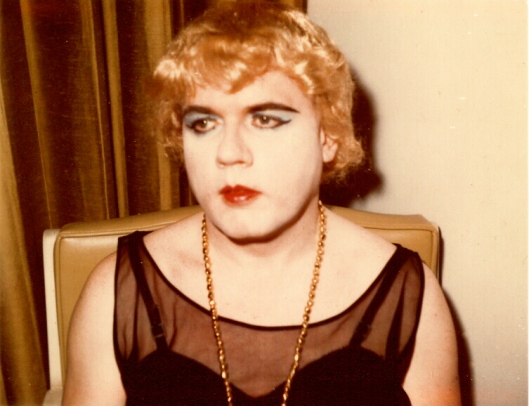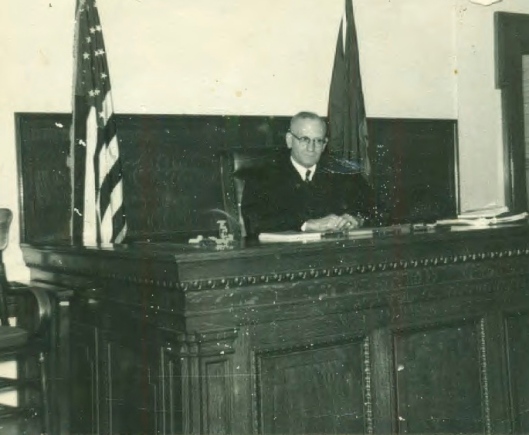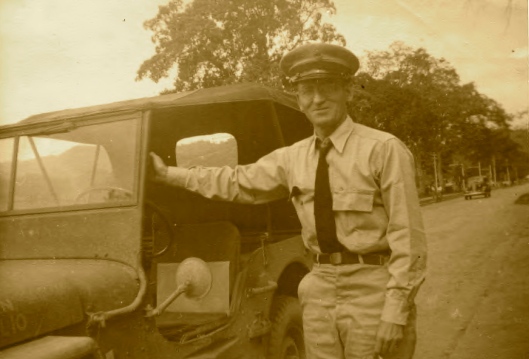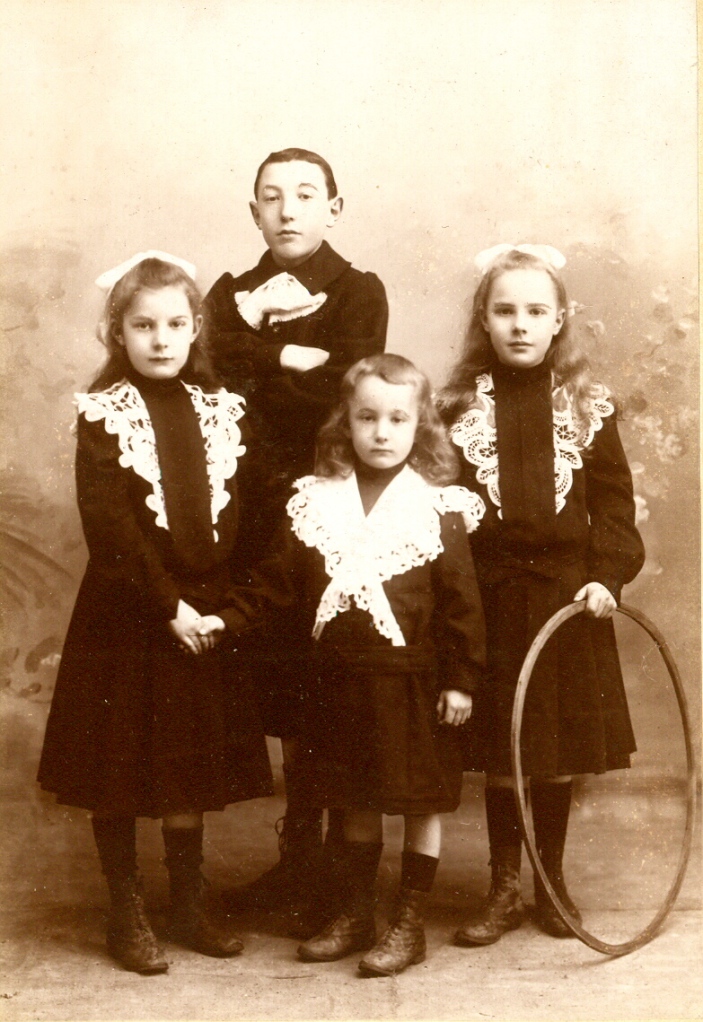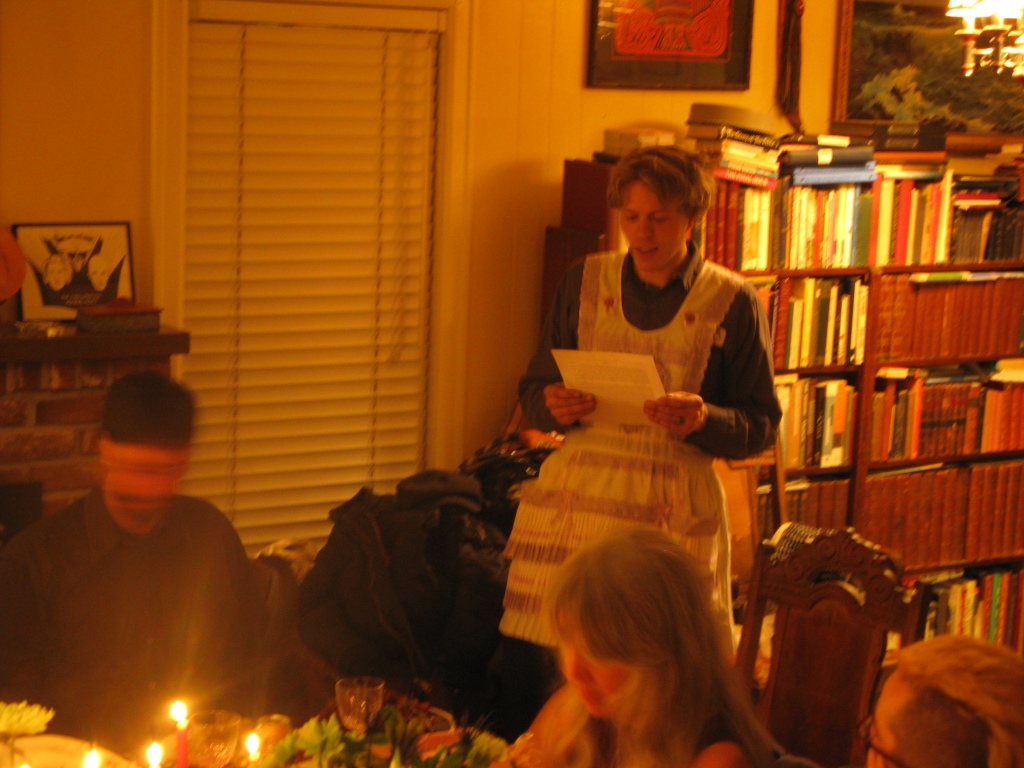I would like to announce that my final edit of Babette is exactly 50% completed. In other news, some readers of this weblog may be aware that I also engage in political writing. If anyone is interested, I am providing a link to my most recent article, reviewing a book on violence in the American civil rights movement.
I’d like to thank Angela Gardner, the managing editor of a website focusing on transgender issues, for publishing an article I wrote about Babette. You can check it out at TGFORUM.
In other news, my final edit is about 30% done. At current progress, that should mean just a few more weeks until I can dot the last period, laugh maniacally, and make myself a stiff margarita…Thanks to everyone for sticking with me on this journey.
Dr. Ellsworth in drag, early 1960s, Portland.
Babette presents a complicated character in every regard and the political aspects of her sexuality are no exception. While she lived as closet transvestite her whole life and paved new ground, both by the late age of her surgical transition at sixty-six in 1994 and through public acceptance of her teaching career afterward that same year, Babette was no activist. She was an opportunist.
The current stereotypical narrative of sexual minority struggles in popular culture fixate on noble individuals who triumph against bigotry to share the lesson that no matter our born gender, sexual orientation, etc … we are all human beings who deserve equal social treatment.
As an abstract concept, Babette agreed wholeheartedly with such sentiments, yet she often told me. “I am not a hero. I am a survivor.” Her childhood experience in WWII era France with an adopted family who were public supporters of Germany and subsequently killed for their sympathies taught Babette lifelong lessons in accommodation. She showed everyone the side of herself they wanted to see. Catholic parishioners knew her as an extraordinarily devout religious woman. Anglican friends knew the eccentric professor with deep Biblical knowledge. Right-wing friends appreciated her spirited defense of Margaret Thatcher, Augusto Pinochet and Francisco Franco. Leftists appreciated her devotion to Robert Ingersoll, George Orwell and East Germany. Intermeshed between all this, the real Babette pursued personal interests as she saw fit.
Sexual minorities are often seen as victims, but Babette was nobody’s victim. While male, she pursued relationships with other men when it served her purposes. In 1944, she ran away from her family in Southern France after they came under attack for Fascist sympathies and took shelter with a gay Parisian film producer. Babette later imparted how she furthered her academic career through a relationship with the well-known French historian Henri Guillemin. Despite this willingness for homosexual conduct if it might prove advantageous, Babette preferred women over men, no matter her own physical gender.
In the late 1990s, Portland Community College asked Babette to become a staff advisor for the campus LGBTQ group. She agreed, not out of any particular interest in furthering gay rights, but to make herself more valuable as a senior educator who feared being pressed into retirement. I remember Babette attended a few months worth of meetings before resigning the post. She claimed her chronic leukemia made the additional work too arduous, but afterward told me a different story.
“These people make sexuality the focal point of their lives!” she complained. “For someone to define themselves totally by who they want to sleep with is unforgivably tedious. I simply couldn’t bear it any longer.”
This may seem an unfair comment, coming from someone who spent decades of their life secretly snapping risque self-photographs in lingerie and eventually spending $50,000 on a sex-change operation, yet for Babette, that part of her life was only one passion among many. She cultivated an old-fashioned mentality, considering sexuality to be a private affair, something hidden as necessary and only revealed during intimate moments. As a historian, she of course recognized the value of bringing GLBTQ issues into the open as a means for social progress, but still, her sensibilities found it deeply distasteful.
Babette was no activist because activism requires risks. Instead, she found contentment practicing deviance behind a veil until the groundbreaking word of others made change of sex acceptable. She is best remembered during Gay Pride, not for heroics, but ultimately as a person who refused to let unfriendly times for the transgendered keep her down.
I had hoped my next entry would be something along these lines:
Babette is back from the copy editor and will appear in print June 18th!
Sadly, this is not the case. My brilliant editor, Lane Browning, spent two weeks picking over each of the 100,000 words in the manuscript and two days ago returned a version that still needs adjustment. Earlier estimates predicted a June release, but given my heavy work schedule, that seems optimistic. If I could just lock myself in a closet for one week with my laptop, bottle of 1800 Reposado tequila and some tortilla chips, this book would appear on schedule. Still, I am a significant step closer. Thanks to Lane and everyone else for hanging in there.
“A recent survey showed that about half of the young high school students believe that some super-authority should decide what is best for the people, and almost that many believe freedom of the press should be abolished. A third are of the opinion that some people should be denied freedom of speech. . . Unless a vigorous and vigilant public opinion can be aroused there will soon be no freedom of thought or freedom of the individual in this country…”
Portland District Court Judge Raymond D. Shoemaker in the Oregonian, April 1958.
The Judge at work.
One of the most interesting people whose story appears in BABETTE is Raymond D. Shoemaker. Shoemaker was born in 1894 and grew up in rural Montana. As a young man, he joined the 2nd Helena Montana National Guard and in July of 1916, was sent into Mexico. Shoemaker showed himself to be quite a singular individual. For instance, while fighting against Pancho Villa’s forces as part of America’s incursion into Mexico’s civil war, he took the time to absorb Spanish and remained fluent his entire life. Years later he also learned Arabic and Thai.
Shoemaker at age 22, en route to Mexico.
Raymond Shoemaker developed into what early 20th century Americans called a “free thinker.” This was not usually a compliment. As such an individual, he viewed authority with skepticism, didn’t condemn individuals because of their race or gender and denied supernatural powers, especially gods. Shoemaker took great interest in law and became a shorthand court reporter after returning to civilian life and moving to Portland, Oregon. After years of legal work and studying to become an attorney, in 1936, he was admitted to the state bar.
During these years, Shoemaker married and raised four sons. He also studied many Western free-thinkers, from Ambrose Bierce to Robert Ingersoll and Charles Darwin. In particular, he avidly collected the Little Blue Book series Immanuel Haldeman-Julius published, everything from pamphlets on evolution to inflammatory tracts such as “The Lies of Religious Literature” by Joseph McCabe and “The Ghastly Purpose of the Parables” by Robert Hughes. Shoemaker enthusiastically underlined favorite passages, loaned them out to friends (as evidenced by a variety of margin handwriting) and even contributed personal insights on blank pages.
February, 16th, 1926 he wrote:
“The poverty of the masses in all ages has been the direct and logical result of their slavery = chattel slavery, feudal slavery, wage slavery – given economic freedom, all men and women can earn and enjoy a good secure living.”
and in an undated notation:
“A man who rolls the mantle of prejudice about him and refuses to consider any measure on its merit is fit only to starve. He is an encumbrance on the earth and should give way to others. Man must improve with the times and the relationship of men to property must change– or the majority must get off the earth, because no food will be allowed them.”
plus in verse form from a pamphlet published in 1925:
How cruel are much of man’s emotions,
How mad are many of his ways,
But the cruelest of all his silly notions
is war.
The slashing, crushing,
crashing, gushing roar
of it:
The leering, shearing,
awful smearing ruin of it.
All stand in everlasting proof
of what will happen in the future.
The delegates may ruin the roof=
they never can change our
human nature.
Shoemaker in WWII, center, wearing officer’s cap.
Despite this description of warfare, years later Shoemaker volunteered with the Navy Seabee during WWII and served as a chief yeoman in the South Pacific. Upon returning home and resuming law practice, in December of 1950 he was appointed a District Court judge. This opportunity gave Shoemaker power to exercise authority the way he thought it should be.
His first unusual act came about in April of 1952, when a case appeared on Shoemakers docket involving a local woman who was bedridden. Not wishing to inconvenience the invalid, he declared her house a temporary court and required every person involved, from witnesses to jury, to meet in her living room.
While this kind decision earned him sympathetic media attention, Shoemaker then moved onto more controversial politics. In May of 1954, he published a newspaper article criticizing Senator Joseph McCarthy and excesses of his anti-Communist crusade, before 1956 saw him take on an abortion case and the next year become legal advisor for a group opposing the death penalty. Soon afterward, he wrote another article vehemently condemning racism as the Little Rock 9 school integration clash unfolded in Arkansas.
Then in May of 1959, Judge Shoemakers greatest battle arrived full force. Outspoken leftist political opinions won him few friends on Portland’s police force and at last, these enemies united against him. It began with claims Shoemaker didn’t hand down harsh enough punishments against traffic offenders, and in particular, that he considered posted speed limits in business districts to be more of an advisory after hours when shops were closed. When two deputies attempted to discuss a particular case with him, the Judge “displayed temper and ordered them from his chambers” saying for officers to dispute his decisions was nothing less than contempt of court, adding “it is the job of deputies to arrest a man and not to judge the case…” (Oregonian, May 28th 1959).
Multnomah County Sheriff, Francis Lambert, reacted by calling for a boycott of Shoemaker’s court and reassigning traffic and misdemeanor cases to Gresham. This opened the door to other complaints from unnamed officers in the newspaper, one stating resentment that Shoemaker “…makes a fool out of you in court and makes accusations against you so that it seems you’re the one on trial instead of the arrested man.” In response Shoemaker declared “A judge has a duty to stand between the public and some of these deputies who want to make a police state out of this country.” (Oregonian, May 29, 1959).
This dispute became so heated that eventually the district attorney became involved to mediate between Judge Shoemaker and Sheriff Lambert. The boycott was called off, but Shoemaker stubbornly refused to make any concessions. In fact, only months later, another public argument erupted between the two officials after Shoemaker suspended the 300 day jail sentence of a young felon who had been offered steady work by a local rancher. Judge Shoemaker found this man to “have a good chance for rehabilitation” and stated “justice should be tempered with mercy.” (Oregonian, September, 1959).
These last months have been especially exciting as a conclusion to the Babette project draws near. This last weekend I finished a final rewrite based on comments from many dedicated reviewers and the manuscript is now undergoing a thorough professional copy edit. My current expectation is that every period and comma should be in their proper place before long.
The opinion of publishing industry apparatchiks who generously gave me their time, is that a story concerning the adventures of a French-Nazi-transsexual-atheist-nun needs to prove its value before being taken seriously for a traditional book deal. The best way to do that is by independently publishing Babette and blowing her up as big as I can. It won’t be much longer before I can have this thing in print, most likely through Lightning Source as a distributor of analogue as well as digital copies. My prediction is a June release. Thanks to everyone who helped me along the way.
As the first update to this weblog in nearly five months, there is a good deal of writing progress to report. This last summer I brought my book proposal to the 2012 Willamette Writers Conference and met with unexpected success after speaking with agents, several of whom kept in touch and have provided valuable feedback toward making the Babette project a viable memoir.
Chief among those observations is length. I cut the manuscript down from 145,000 words to around 94,000. As one might imagine this required major revisions, painful edits and the elimination of entire characters– not fictional creations, but real people I know and love. While at times agonizing, this metamorphosis has proved a liberation. The resulting storyline feels much more streamlined and manageable, yet still retains the essential content of its more lengthy manifestation.
After the completion of this process, I brought my newly revised creation down to Powells Books here in Portland where there is a small run book press. For around a hundred bucks I was able to print up six copies which have been circulated among various people for their critiques over the last month. There is still much work to be done but the main effort now lies behind me. One way or another, an authoritative version of Babette: The Many Lives, Two Deaths and Double Kidnapping of Dr. Ellsworth will see the light of day in 2013.
“But what about Germaine?” I ask, “did your mother survive the war?”
“Ah, yes,” Babette muses, “now there was a woman, my mother. To answer your question, yes, she survived, though after the war as our family disintegrated, I lost her. But what she managed impresses me to this day. She portrayed herself as a member of the glorious French resistance and convinced some Jewish aid agency to pay for her voyage to America, then moved to Duncan, British Columbia and became the governess to children of a wealthy family. I remember once she actually lectured at a church, something or other about the horrors of Nazism and how she survived. I sat in the back, barely able to keep a straight face. Afterward she pulled me aside and told me ‘If you say a word, I’ll cut your throat!’ Oh, I couldn’t believe her audacity!
A couple months following Babette’s death on February 16th, 2002, I organized a memorial dinner party. About sixteen friends came over and we feasted on a gigantic twenty pound turkey she bought months previously. This was the last time I entertained in her grand house on Tolman Street and we did it with style. Crystal wine glasses, fine porcelain plates and the best dinnerware from Babette’s china closet spread around the table as we ate and reminisced about the strangest individual to ever enter our lives.
On February 17th, 2012 I hosted a ten year deathaversary to honor Babette, on the same china plates, though this time serving salmon and rockfish caught while commercial fishing in Alaska the summer before. Fourteen people who had either known Babette or assisted me with writing about her, came to eat, including several friends who attended the original dinner so many years ago. Ten red candles adorned the table and as a centerpiece, flowers sprouted from the plastic urn which originally contained my professor’s cremated ashes.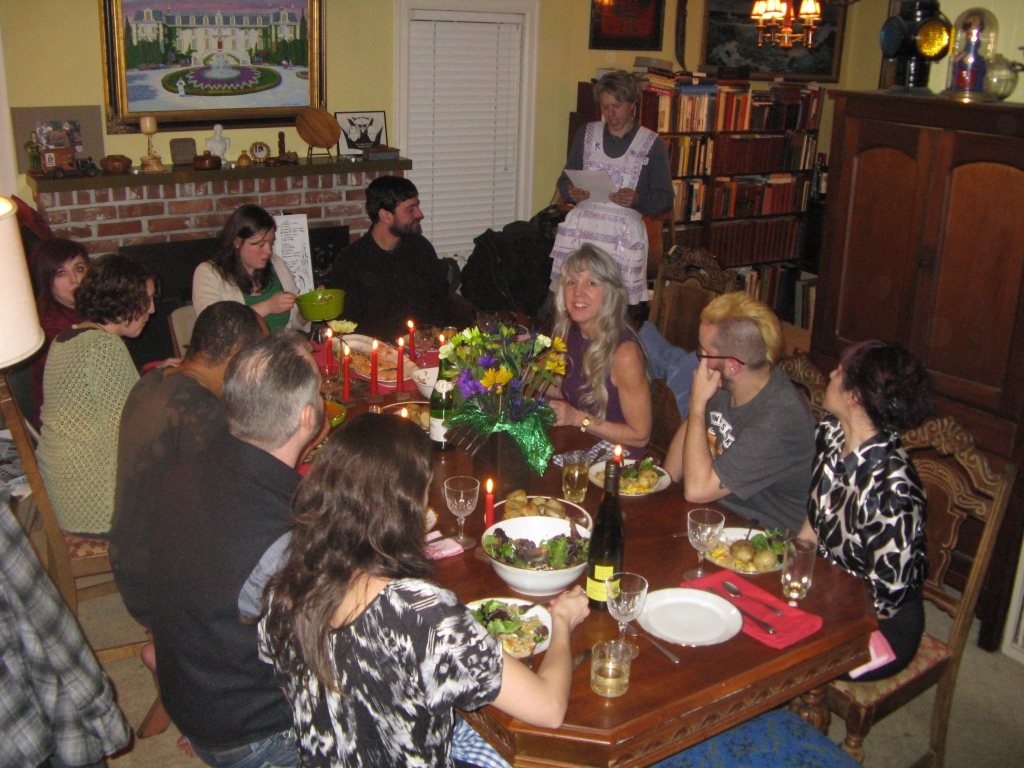
Babette greatly admired Roman culture so I researched relevant customs and discovered Roman funerals often included mourners consumed as the deceased besides fervent eulogies delivered in their praise. Therefore, with one of her wigs on my head and wearing a lavender apron, I spoke in remembrance of a friend still sorely missed. After dinner, everyone gathered around and I showed slides from her life, as a child at the Chateau du Lac in Southern France to later international travels and photographs taken in drag at a series of cheap motels as well as other locations. The final picture was Babette standing alone, her pudgy male figure bundled into ill-fitting feminine garments and a curly wig balanced on her round head as she faced out over the Pacific Ocean from a lookout at Seaside, Oregon.
A Roman Eulogy for Albert J. Ellsworth AKA Robert Brown Jr. AKA Elizabeth Bonnefont
or
BABETTE
The Roman rhetorician Quintilan declared “deficit omne quod nasciture” meaning “Everything that is born passes away.” These words are true, but I speak in commemoration of a friend, dead these last ten years, who experienced a more total human experience than any other. Someone who lived both as a man and as a woman. As a devout Catholic but also a committed Nihilist and Atheist. As a respectable professor who regularly lectured before the Portland city council- yet who abandoned his family to live for many years in an unorthodox relationship with a local judge and his wife. As a lifelong closet transvestite who underwent sex change surgery in his sixties but took a dim view of the modern gay rights movement. Someone who possessed the most educated and brilliant mind I ever encountered yet went to her grave considering Hitler a misunderstood genius. As a person capable of unfathomably generous acts or capricious cruelties, she declared honesty a supreme virtue, but thrived within webs of compulsive lies.
In all these ways Babette’s life spanned what most people would consider extreme opposites yet if anything consistent defined her being it was absolute iron determination to succeed at whatever she attempted. This was a person who came to the United States in 1946 at the age of 17 with only a rudimentary knowledge of English, then ran away from her birth family in Yakima and by 1949 graduated from the University of Portland. A passionate professor of history, among many other subjects, she not only taught multiple generations of community college students regional Northwest history and took them on tours around Oregon and Washington, she organized large scale trips all across the world, lecturing in Europe, Canada, South America, North Africa, and China. Then in her mid sixties, she underwent an accelerated program of therapy and hormones to prepare for surgical M-F sex reassignment despite the risks associated with such radical procedures at her advanced age. Most people would have been content to retire and enjoy moments of leisure in their seventies, but Babette continued to teach literally up until the moment she died, collapsing from a heart attack in front of forty students preparing to attend her Mt. St. Helens lecture tour on February 16, 2002.
Babette’s favorite Roman philosopher, the emperor Marcus Aurelius wrote “Death is a release from the impressions of the senses, and from desires that make us their puppets, and from the vagaries of the mind, and from the hard service of the flesh.” For Babette nothing less than death could release her passions and desires, the driving will that rode her mercilessly and at last changed even the born gender of her flesh.
I once asked Babette what she would have done if she lived in the Garden of Eden and was forbidden by God to eat from the Tree of Knowledge. She replied under such circumstances she would have consumed a whole orchards worth. So that is who we commemorate here tonight. A complicated individual whose life I will never fully understand but which I still honor in the depths of my heart.
One of the first adventures I accompanied Babette on was a trip to Eastern Oregon where we spent a weekend at the old Rajneeshpuram site during the summer of 1999. The Oregonian recently published an interesting multi-part series on the commune which lasted for several years in the 1980s. http://www.oregonlive.com/rajneesh/
The Reich Nicht I
In late August my professor sits me down for a proposition.
“You see, Wrahs,” She tells me, “I now only take students on local bus tours for the community college, none further than Seattle, as I tire so easily, but years ago we would charter airplanes and visit distant places like Beijing, Moscow, Cairo. The whole wide world! For me this was a fantastic opportunity to travel and lecture on subjects I love and be paid for doing so. But those days are long gone and I must be satisfied with the Pacific Northwest.
This next school year I will continue my limited trips– the coast, Mt. St. Helens, southern Oregon and so forth. I would like you to accompany me and assist.”
“Certainly,” I agree.
“So,” she continues, “one of my favorite tours is the central Oregon high desert. We take Highway 84 east along the Columbia River. You will see the most fantastic geology exposed by water through the gorge. We visit a delightful little town called Shaniko, which used to be a major sheep exporter, Fossil, where, as you might imagine, there have been many geological finds, and also Antelope. Do you know the significance of that place?”
I shrug. “Not that I can think of.”
Babette rolls her eyes. “Well, since you can’t be bothered to learn your own regional history, I will tell you. During the early 1980s, an Eastern spiritual leader called Bhagwan Shree Rajneesh relocated his commune from India to a large ranch near that town.” She pronounced Rajneesh thickly as Reich-Nicht.
“Of course religious social experiments are nothing new to Oregon. Do you remember the old Aurora commune we visited near Mt. Angel? Well, the Reich-Nicht Puram, as they called it, was much larger and consisted of several thousand people at last. They worked the land, dammed a creek for irrigation and lived in small huts. It seemed a meager existence, but they wanted to focus on spiritual affairs. The Reich-Nicht Puram attracted numerous Western converts, who in many cases came from affluent backgrounds, but contributed their wealth to the community.
“This appeared strange because the Bhagwan afforded himself great style with a fleet of Rolls-Royce automobiles. It sounds vile, but is this any different than the Christian tradition, where congregations may live amidst absolute poverty but worship in a beautiful church while tithing so grand cathedrals can be built?
“At any rate, while the Reich-Nicht Puram toiled away industriously, other central Oregonians were not so happy with such an unusual group in their midst. It became popular to criticize the Bhagwan for his excess and local people found it obscene that his followers might bathe in the stream naked or what-not. I don’t care for this religion personally, but the people seemed happy, though of course it was supposed they must have been brainwashed.
“I observe this because I contacted a woman named Sheela, who if you ask me was the real power there, and received permission to make their commune part of my high desert tour. We would bring in a bus full of forty students to view the area and see what we wanted. Everyone was quite friendly and this went one for several years but then after some property disputes, a commune building burned down mysteriously as well as some other incidents changed things. Well, the Reich-Nicht Puram reacted as any people do when under attack. They prepared to defend themselves and became much more closed in. Going through their security procedures no longer made sense with time requirements for the rest of my tour and I lost contact with them.
“Then in 1986 catastrophe struck. There seemed to be an internal struggle within the group leadership. Sheela fled to Europe and a great number of people became sick in the town of Antelope after eating at a restaurant owned by the Reich-Nicht Puram. The government swept in and uncovered a conspiracy to poison regional water systems as well as massive immigration fraud. With his commune destroyed, the Bhagwan traveled back to India where he died some years ago, though this sect still exists under the name Osho. Their land went up for auction and was purchased by a wealthy rancher from Montana. Then, not too long ago, I found out he had donated the property to a Christian youth organization called Young Life.”
“Oh, I know about them!” I break in, “my parents worked for that group before I was born.”
Babette nods. “I possess a connection there as well. My sister, though you perhaps did not know that I have a sister, is a Young Life minister.”
I shake my head.
“Well,” she continues, “Young Life renamed the Reich-Nicht Puram as Wild Horse Canyon and started a summer camp program which is just ending its first season. They have invited a select group to view their transformation of this center for evil paganism by their much more socially acceptable religion. My sister found a way to put us on their list for next weekend. Would you like to accompany me?”
“Yes! I exclaim.
Babette smiles. “You know what a pagan is, don’t you Wrahs?”
“What, literally?”
“Literally linguistically.”
I think for a moment. “No.”
Babette bobs her head. “It makes so much sense. What is one of the main characteristics of Christianity? That it took root as an urban religion. City dwellers no longer found spiritual resonance among gods based on agricultural patterns or natural cycles. Where is power located in an ancient metropolis? A king, a ruler, a strong man! So they looked for something else to translate their religiosity into, often a messiah figure. But out in rural areas, what are called in Latin the pagus, old beliefs tended to remain. Therefore, a pagan is someone from the boondocks! Very similar to the term heathen, which of course means people who live out on the heath. Look at all this knowledge I pass on for no extra charge!”


